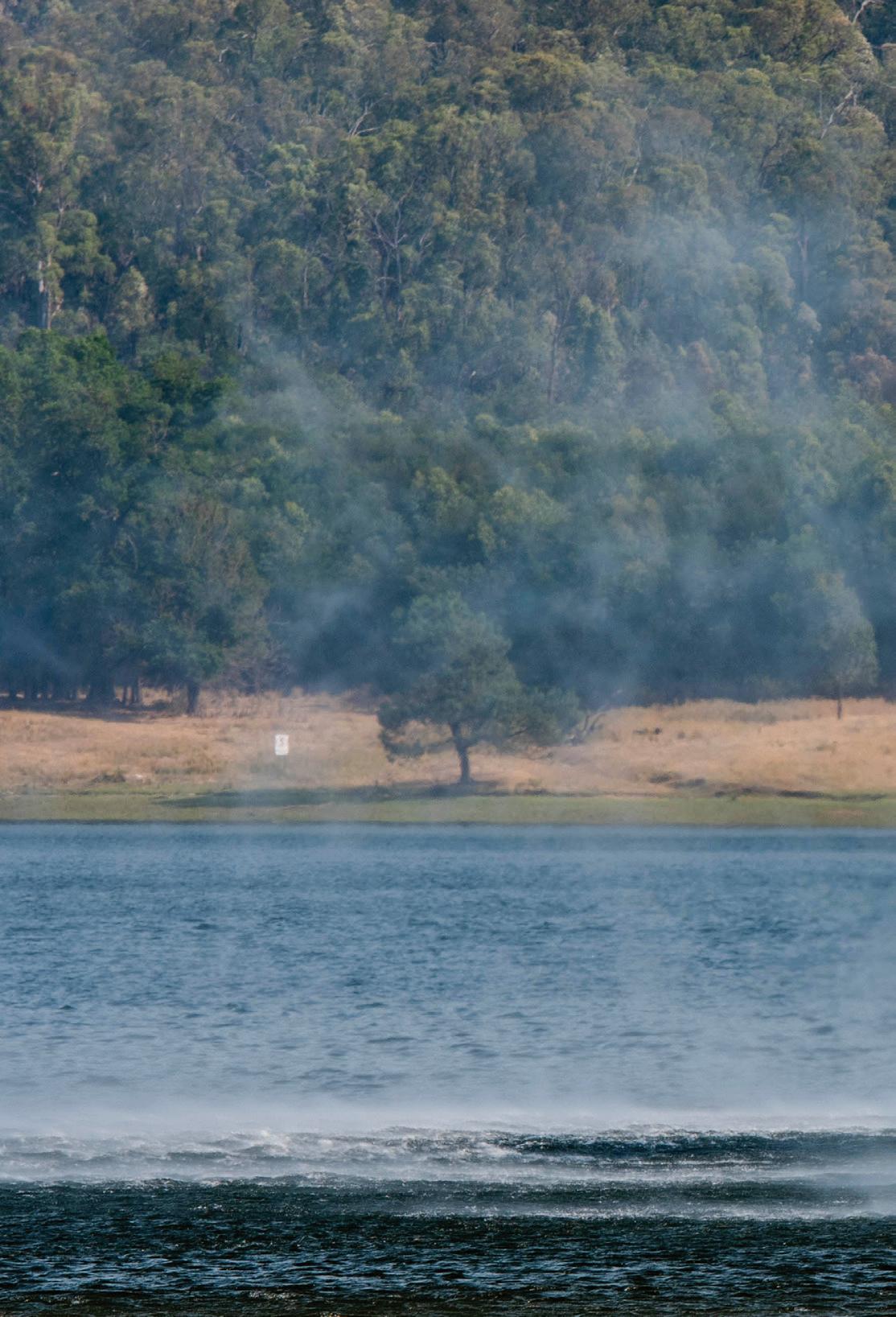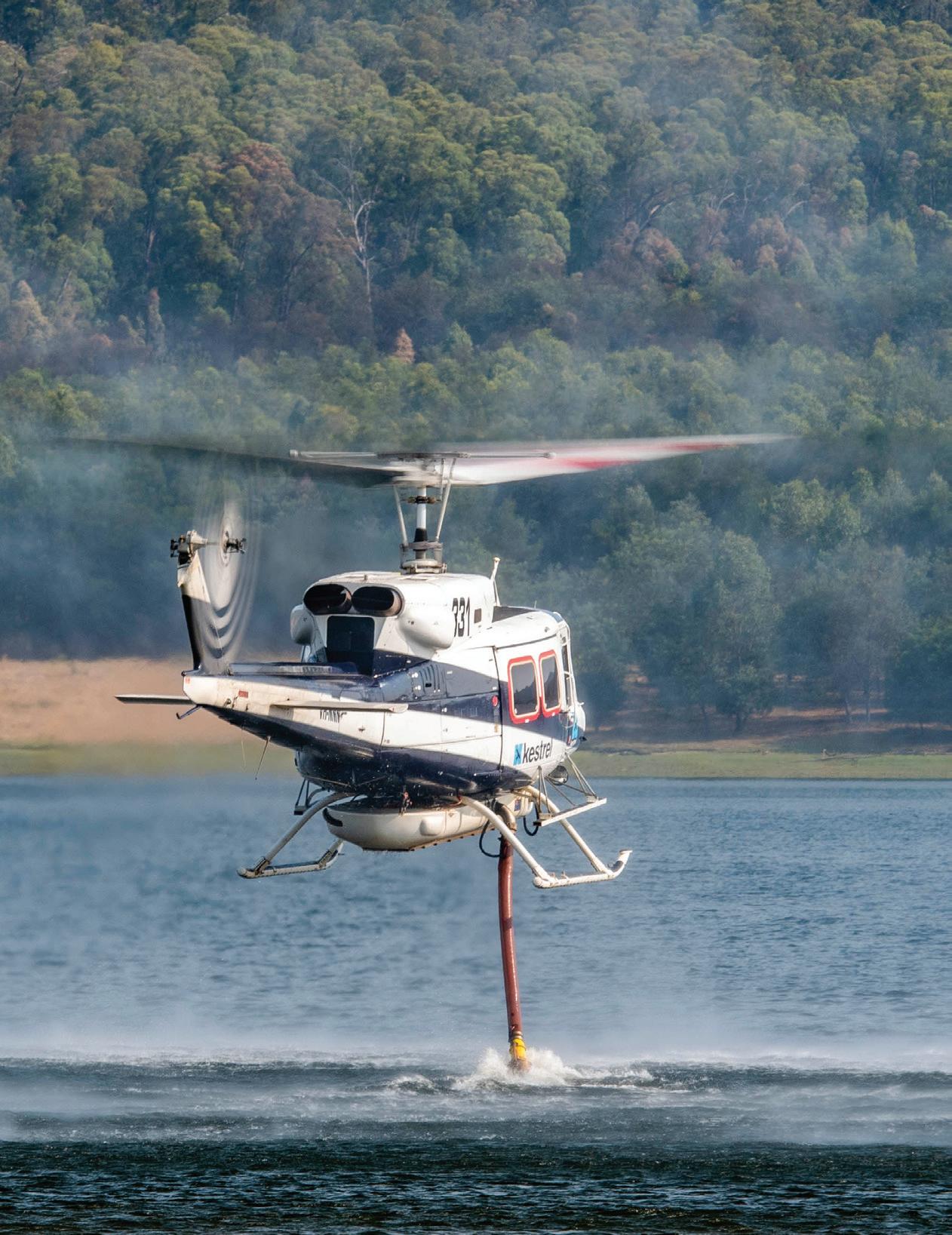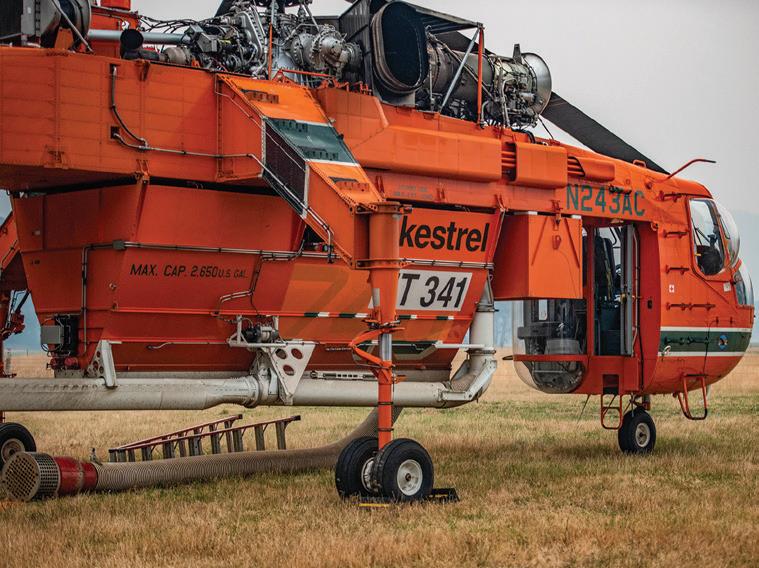
8 minute read
Kestrel Aviation Innovating To Keep Australians Safe
KESTREL AVIATION
by Ryan Mason
INNOVATING TO KEEP AUSTRALIANS SAFE
Beginning operations in 1985, many would be surprised to know that Kestrel Aviation began not an aerial firefighting company, but as a training provider. Although training is still a significant component of what the company does, Kestrel Aviation has grown to be very different from its humble beginnings in the 1980s.

Above: Kestrel Aviation founder Ray Cronin Left: Kestrel Aviation has a long standing business partnership with Oregon based Erickson Aircrane that sees multiple Air Cranes shipped to Australia for firefighting operations managed locally by Kestrel.



Above Left: Kestrel Aviation has partnered with U.S. based Firehawk Helicopters to bring Black Hawk helicopters to Australia to fight fires for the next several years.
Below Left: Kestrel operates several different Bell models that include mutliple Bell 412’s like this model seen training near Mangalore, Victoria.
Above Right: One of Kestrel’s 212’s rests among the smoke of the Mansfield fire operations center during a firefight during our visit in January of 2020.
Below Right: Kestrel’s night aerial firefighting team pose for a photo before night testing of aerial firefighting operational effectiveness.

The founder of Kestrel Aviation, Ray Cronin, identified a need for quality helicopter training in Australia’s early 1980s. He also decided to be the change he wanted to see in the industry by starting Kestrel Aviation.
As the industry changed over the years, Kestrel continued to change and adapt, adjusting the business focus. As the company grew, Cronin moved location from Moorabbin in the eastern suburbs of Melbourne to Mangalore, situated an hour north of Melbourne.
The move to Mangalore was made for the more stable climate of inland Victoria, offering a much more conducive environment for helicopter flight training. It also enabled Kestrel to expand its training program for its overseas students by providing onsite accommodation and expanding the fleet and facilities.
Flight Training Before Firefighting
Initial flight training operations commenced at Kestrel with several Bell 47 helicopters. Cronin flew as both a business owner and flight instructor before switching to a Robinson R22 fleet in the early 1990s. with the improved operating costs of a newer aircraft was cheaper to maintain. Robinson aircraft offered that. Compared to the much older Bell 47’s we had, our continually dwindling parts inventory became harder and harder to replenish over time.” said Cronin.
Kestrel Aviation continued to grow as a training company with a solid international reputation, attracting students from all over the world, developing to a fleet of ten Robinson R22’s flying constantly with the rapid influx of domestic and international student base that continued to grow.

Adjusting the Business Model
Kestrel’s flight training operations flourished at Mangalore, with students from Japan, South Korea, India, Sri Lanka, and other countries worldwide.
During his time spent training Japanese pilots, Cronin identified a need to provide multi-engine training and purchased a BK117 helicopter to meet Japanese clients’ needs. The BK117 was a regularly used helicopter in Japan before many state and federal agencies transitioned into the AS365 and later the AW139 helicopter.
Since its very early days, Kestrel had also provided helicopters to Victoria and NSW for aerial fire fighting with both the B206 and the H369. Wanting to increase the utilization of the BK117, Cronin investigated the use of a belly tank on the BK117 for fire fighting to increase the capacity of the water being dropped and provide a twinengine option to the various fire agencies.
Partnering with Simplex Aerospace in 2000, the two companies worked together to certify the first BK117 belly tank. The 1000 liter (264 Gallon) external belly tank was a game-changer for Kestrel.
Seeing the advantages of belly-tank equipped fire fighting helicopters, and the shortage in Australia, Cronin developed a partnership with Canadian-based Tasman helicopters. The company’s Bell 212 helicopters would transition between the Canadian summer fire season and Australia that lasted several years. They added the benefit of using a larger aircraft with a water capacity for drops increasing to 1500 liters per bucket drop (396 Gallons) from 1000 liters. During this time, Kestrel purchased their own Bell 212 and, over the years, increased their fleet as the demand for belly tank equipped multi-engine helicopters grew.
Technology and Innovation
As aircraft purchases continued, so too did development and innovation efforts at Kestrel. Cronin and his team continued investigating the best options for aerial firefighting for each aircraft the company deployed. As Cronin continued to streamline operations, he invested in external tanks for aircraft, starting with the Conair 85 medium tank. Initially installed on several Bell 212 helicopters, which he believes to be the best medium tank in the business.
Kestrel was also integral in obtaining Australian certification for the same tank to be installed on the Bell 412. The company was also sourcing further 412 airframes to add to its fleet for firefighting efforts in Australia.

After buying several Conair 85 tanks from an operator in Canada, Kestrel began upgrading them. Each now features

Left: One of Kestrel’s fleet of Bell 412’s participating in night aerial firefighting testing before being approved as the first night aerial firefighting operation in Australia.

Below: Firebird 331, a Bell 212 fills with water during firefighting efforts outside of Mansfield, Victoria during the 2020 fire season.
electric Kawak brushless pumps that have been upgraded from their earlier hydraulic systems, speeding up filling the tank from 50 seconds to 19 seconds per fill.
In 2008, Kestrel continued its acquisition of aerial firefighting capable aircraft. Thanks in part to their already solid relationship with Japanese authorities from years invested in training Japanese pilots, the company was able to purchase several former Japan government Bell 412s.
Partnering for Success
Kestrel now operates a fleet of six Bell 412s, five Bell 212’s, and a Bell 206L owned by the company. In recent years, however, the company has continued to expand through partnerships.
In 2013, Kestrel partnered with Oregon based Erickson AirCrane. The company would go on to provide a total of six Erickson S-64 Air Crane® helicopters around Australia. Two are located in Victoria, two in New South Wales, and one in South Australia and Western Australia. This contract was initially a five-year contract that has recently extended for an additional five years. The contract deploys the aircraft to Australia every fire season to assist in firefighting efforts.
“When we looked at what the market was doing and what the future of the aerial firefighting industry needed going forward in Australia, it was clear that the industry needs aircraft with larger capacities to fight some of the fires we have in the 2019/2020 season,” when asked about future expansion said Cronin.
Kestrel is already ahead of the game related to larger aircraft, partnering with Florida based Firehawk Helicopters. Their partnership will see two Firehawks S-70 helicopters spend the Australian summer down under fighting fires.
When asked about the development of a relationship with Firehawk while the operation of Blackhawks in aerial firefighting in Australia is still relatively new, Cronin stated that they partnered with the right company by choosing Firehawk. Firehawk is a company that has been at the forefront of development since the very beginning of the Blackhawk airframe after its release into the civilian market, so they have a great deal of maturity related to that aircraft market.

Setting the Standard
Kestrel is no stranger to innovation. That trend continued in 2017 when the company was asked by Emergency Management Victoria to participate in the first Australian trial of night firefighting using Night Vision Goggles (NVG.) Kestrel deployed its team in a Bell 412 for the initial testing phase through 2017, which was then made operational during the 2018/2019 fire season in Australia.
Kestrel has won several awards that include an international aerial firefighting award at the European Aerial Firefighting conference in 2019, an award for their outstanding contribution to the aerial firefighting industry in Nimes, France, and an award from the Airborne Public Safety Association in 2019 for championing the use and need of night vision equipment outside of North America. The company is also a finalist in the A20 Aerospace awards to be held in 2020.
When asked about the 2019/2020 fire season and its impact on the company, Cronin stated that there wasn’t an easy way to describe the last season. It tested everyone’s abilities and was an incredible challenge for everyone, from the government agencies involved to the dozens of contract companies such as Kestrel. He noted that the company had dropped over 60,000,000 liters (approximately 16.1 Million gallons) through the last season, which exceeded any previous season.
Cronin explained that the company doesn’t have a grand vision of being the biggest aerial firefighting company in Australia. He instead concentrates on the quality of the service they already provide to their customers. Cronin says he prefers concentrating on what they are good at, which seems to be a business recipe that keeps the company working year after year, keeping Australians safe.
Left: Two Erickson Air Cranes sit at Essendon Airport in Victoria, Australia awaiting dispatching to the fire line.
Top: A Firehawk/Kestrel UH-60 sits awaiting fuel afrer firefighting efforts in Australia
Middle: Erickson Aircrane “Marty” begins nightly maintenance after fighting fires in Mansfield, Victoria in January.
Bottom: Some of Kestrel’s fleet of 212’s & 412’s sit at their base in Mangalore, Victoria.













